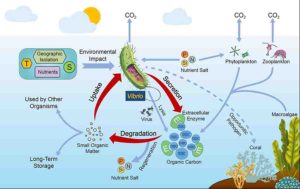
The genus Vibrio is one of the best model marine heterotrophic bacterial groups, and many Vibrio species grow very quickly with short generation times. In addition, many Vibrio spp. are well-known bacterial pathogens, causing disease in humans or marine animals. For example, Vibrio cholerae is the causative agent of cholera. Over the past 40 years, many nonpathogenic species of Vibrio have also been described.
Vibrios are ubiquitous in estuarine and marine environments on a global scale, especially in coastal areas. They are easily cultured on standard or selective media and are capable of a diverse array of metabolic activities. Also, vibrios are capable of responding rapidly to nutrient pulses with explosive growth responses in amended microcosms, such as during phytoplankton blooms and dust storms, suggesting that the short period of Vibrio blooms should be considered when attempting to determine their overall contribution to the recycling of organic macromolecules. Currently, the role of Vibrio spp. in marine organic carbon cycling, particularly in coastal environments, is underestimated.
In an article coauthored by Xiao-Hua Zhang, Heyu Lin, Xiaolei Wang and Brian Austin, scholars at College of Marine Life Sciences, Ocean University of China, and the Institute of Aquaculture, University of Stirling, U.K., provided an overview of distribution and environmental drivers of Vibrio populations in the marine environment, and discussed their potential role in marine organic carbon cycling.
These four scholars proposed in the study, which was published in Science China, that “Vibrio spp. may exert large impacts on marine organic carbon cycling especially in marginal seas.” In addition, they proposed a potential action mode of Vibrio species in marine organic carbon cycling (Figure 1).
“All currently described Vibrio spp. are obligate heterotrophs and, as such, rely on organic matter for their carbon sources. Generally, vibrios consume a wide array of organic carbon compounds as carbon and energy sources, with most species being able to utilize over 40 compounds. Many of the polysaccharides are derived from macroalgal cell walls (i.e., alginic acid, agar, fucoidan and laminarin) or zooplankton exoskeletons (i.e., chitin). In our previous work, 56.8 percent of Vibrio cultures (330 out of 581 isolates) isolated from Chinese marginal seas possessed chitin, while 11.2 percent of Vibrio cultures (65 out of 581 isolates) could degrade alginic acid (data not shown). Vibrios are able to engage in both respiratory and fermentative metabolism and transform organic carbon into cell material and the waste products of energy metabolism. During aerobic or anaerobic respiration, large amounts of metabolic end products are excreted. Hence, Vibrio spp. are undoubtedly key players in marine organic carbon cycles, especially in marginal seas,” the authors write.
Reference:
Xiaohua Zhang et al, Significance of Vibrio species in the marine organic carbon cycle—A review, Science China Earth Sciences (2018). DOI: 10.1007/s11430-017-9229-x
Note: The above post is reprinted from materials provided by Science China Press.










